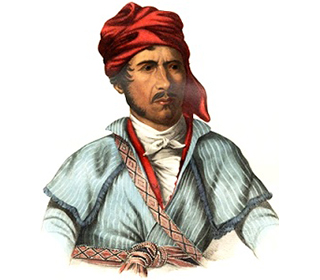The picture of Timpoochee Barnard shows him wearing a turban style headdress that was worn by many of the southeastern tribes. The turban was made with strips of cloth, such as calico, wool, or even silk, wrapped around their head like a turban. The turban style headdress was often decorated with a feather plume which was considered to be of spiritual significance holding great power. What clothes did the early Yuchi wear?
The above pictures clothes show how the Yuchi were greatly influenced by the Europeans and the availability of trade cloth. Prior to this time the Yuchi men were breechcloths made from deer skin or bark fabric. The early Yuchi women wore a knee-length skirt, also made from deerskin or a bark fabric. Both early Yuchi men and women painted their faces for special occasions and also decorated their bodies with piercing and elaborate tattoos. For special rituals and ceremonies the ancient Caddo wore beautiful feather cloaks and feather headdresses. What weapons did the Yuchi use?
The weapons used by the Yuchi tribe included axes, war clubs, maces, knives, pikes and bows and arrows. What did the Yuchi tribe live in?
The Yuchi tribe lived in highly organised villages consisting of grass huts. Each village had a temple, which in ancient times, was located on top of an 8 feet high mound (see Natchez Tribe for more facts about grass houses). The grass houses were built by using a framework of beams and poles that were covered with wattle and daub. The interior and exterior walls were covered by cane mats and the roof was made of tightly clipped thatched grass. What did the Yuchi tribe eat?
The people of the Yuchi tribe ate included their crops of corn (maize), beans, squash, seeds and pumpkin. They also hunted for meat from bear, fox, deer, turkey, rabbit, rodents and other smaller game. The y also gathered wild plant foods. Food was cooked into cornbread, soups and hominy. The people also grew tobacco and a grain-bearing grass. Yuchi History: What happened to the Yuchi tribe?
The following Yuchi history timeline details facts, dates and famous landmarks of the people. The Yuchi timeline explains what happened to the people of their tribe. Yuchi History Timeline 700AD: The Yuchi people moved north from the ancient Mexican empire and the Mississippian culture began 1542: The Hernando De Soto expedition encounter the Yuchi and other hostile tribes in Tennessee which end in violence 1567: The Juan Pardo Spanish expedition also results in conflict with the Native Indians 1542: The Europeans bring diseases such as smallpox and measles. Many Native Indians die 1600's: Violent conflicts with the Cherokee and Shawnee tribes force the Yuchi to move to Georgia and Alabama. Some move even further south to Florida. 1630's: Yachi warriors attacked Spanish settlements in Florida 1729: The Yuchi ally themselves with the Creek Confederacy 1758: The Anglo-Cherokee War (1758–1761) 1776: Timpoochee Barnard, great Yuchi chief, was born 1813: The Creek War (1813–1814) erupted in Alabama and Georgia. Timpoochee Barnard led his Yuchi warriors to fight for the United States against the Creeks 1814: August 9, 1814. Timpoochee Barnard was present at the treaty of Fort Jackson to end the Creek War, signing the treaty as “Captain of the Uchees.” 1817: First Seminole War (1817–1818) erupted in Florida as the Seminole Indian tribe, together with some Yuchi allies, defended their lands and runaway slaves. 1817: Timpoochee Barnard and his band of Yuchi fighters again fight on the side of the US 1821: The first Treaty of Indian Springs was signed January 8, 1821. The Creek ceded land to the state of Georgia in return for cash payments totaling $200,000 over a period of 14 years. The Yuchi are considered part of the Creek Tribe by the United States Government 1825: The second Treaty of Indian Springs was signed on February 12, 1825 but is denounced by the Creek National Council. Timpoochee Barnard opposed the terms of the treaty and was part of a delegation to Washington to have the treaty revoked 1826: The Treaty of Washington was negotiated but it was not honored and the Creeks, and the loose confederation of tribes including the Yuchi, would lose their lands 1830: The Indian Removal Act of 1830 1830: Several Yuchi (Euchee) bands moved farther into Florida and became incorporated within the Seminole Tribe 1834: Timpoochee Barnard died at his home near Fort Mitchell 1834: Members of the Yuchi tribe, with the Creeks, are forcibly marched to Oklahoma. They begin to lose their identity as they are assimilated into the other tribes 1835: Second Seminole War (1835–1842) in Florida. Under Chief Osceola, the Seminole resumed fighting for their land and were decimated as a result 1893, President Grover Cleveland appoints Senator Henry L. Dawes, to negotiate land with the Cherokee, Creek, Choctaw, Chickasaw and Seminole tribes 1893: The Dawes Rolls, or the Final Rolls of the Five Civilized Tribes, entitled an allotment of land to tribe members, in return for abolishing their governments and recognizing Federal laws. The Dawes Commission politically devastated the Euchee (Yuchi) people as it legally classified them as Creeks for the purposes of land allotment. 1934: The individual allotment policy of the Dawes Act was terminated by the Indian Reorganization Act
Yuchi History Timeline |

